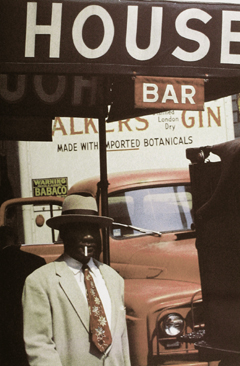Saul Leiter Early Color
Saul Leiter Early Color
For many decades, traditional art photographers considered color to be the poor stepchild of black and white photography. But starting in the late 1960s, an iconoclastic band of young American photographers, among them William Eggleston, Joel Sternfeld and Joel Meyerowitz, took to the street, and irrevocably established color as a vibrant alternative to black and white in the domain of expressive, socially-concerned photography.
Yet only recently has the seminal color street photography of Saul Leiter from an earlier decade, the 1950s, come to be appreciated. Trained as a painter, Leiter was introduced to photography by the Abstract Expressionist Richard Pousette-Dart. Leiter’s picture-making approach, while rightly classified as part of the “New York School” of edgy, off-kilter street photography, brings to the genre a distinctive painterly sensibility and color palette suggestive of Bonnard or de Kooning.
“Selecting small, half-hidden, scenes on the street – or desultory moments glimpsed in his private environment – Leiter has forged a body of images whose distinctively subtle aura qualifies them as a landmark contribution to the still photography of the era,” critic Jane Livingston has written. “They are lyrical without being sentimental and psychologically penetrating without being theatrical.”
Saul Leiter was born in Pittsburgh in 1923. The son of a prominent Talmudic scholar, he was groomed to become a rabbi. But increasingly his ‘hobby’ of painting competed for his attention. In 1946, in a fit of youthful rebellion fortified by positive reviews of his gallery shows in Cleveland and Pittsburgh, he quit the seminary and moved to New York. Soon he had joined the social orbit of the Abstract Expressionists; his paintings were exhibited in various Lower East Side galleries alongside Willem de Kooning’s and Philip Guston’s.
Leiter’s interest in photography can be traced, on the one hand, to the Museum of Modern Art’s seminal 1947 Henri Cartier-Bresson retrospective, and on the other hand, to the deliberately soft-focus photographic experiments of his close friend, the painter Richard Poussette-Dart. Cartier-Bresson’s uncanny ability to capture a ‘decisive moment’ in the theater of the street profoundly influenced not only Leiter, but an entire generation of young photographers including William Klein, Robert Frank and Helen Levitt who came to define the New York School. Leiter married this edgy, modern sensibility to a visually layered compositional approach and a decidedly painterly color palette; he often preferred expired color film stock for its more muted hues which typically veered slightly towards the lavender.
Like a proto-video artist, in the 1950s Leiter would sometimes ‘display’ his color photographs by placing the Kodachrome slides in a carousel and projecting them sequentially onto the walls of his Lower East Side studio or gallery; the transient sensory effect was a good match for the fluid, often fragmented nature of his street imagery. Remarkably, it was not until the 1990s that a significant body of archival exhibition-quality prints from Leiter’s color slides was first executed, including the works in the present show. Only then could his original vision finally be absorbed and appreciated.The exhibition was organized by art2art Circulating Exhibitions. All works are courtesy of the artist and the Howard Greenberg Gallery.

Harlem, 1960
Color photograph
